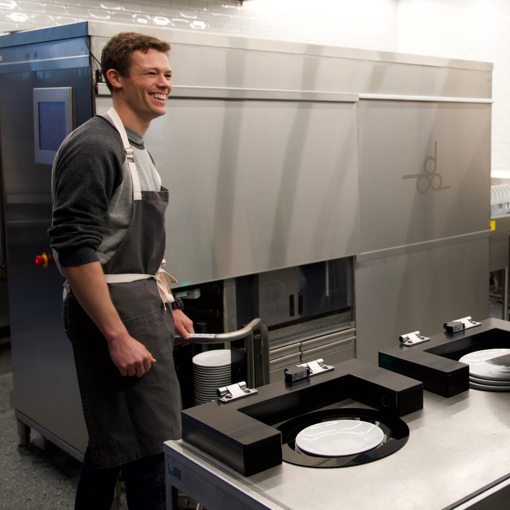
12.2.2021
Linda Pouliot is the co-founder and CEO of Dishcraft Robotics. Serving the hospitality industry, including hotels and resorts, the company’s robotic solution delivers significant improvements over traditional ware washing. Currently, Dishcraft serves the San Francisco Bay Area, with plans to expand to several new cities in 2022. Linda Pouliot has a long track record of success as a serial entrepreneur specializing in robotics. In 2004, she co-founded Neato Robotics with the idea that robots can perform household chores as effectively as humans. At Neato, she was Vice President of Product Management and Operations, where, in addition to product management and operations, she oversaw hiring and manufacturing. The company was acquired in 2017. She also served as COO of Adiri, Inc., where she worked on the internationally award-winning Adiri Natural Nurser. She has also developed products for retail brands, including Disney, Banana Republic, and QVC, as Director of Operations at Gouda. She has been awarded multiple patents and international awards. She graduated from the University of Michigan, Ann Arbor with a BFA cum laude.
Dishcraft has carved out a unique niche as “a robotics company focused on solving labor and sustainability challenges facing hospitality foodservice operators.” What does that mean, exactly?
Operating much like linen service, we deliver clean dishes daily, bringing back the used wares to a centralized hub powered by robotics and AI to wash, sanitize and inspect the items. Our robotics and AI enables a more sustainable solution, addresses labor gaps and improves dishwashing jobs. The system uses one-tenth the power, one quarter the water, and one-eighth the labor compared to a traditional dishroom operation.
Who are your customers? What are the biggest benefits your company delivers?
Our customers include corporate cafeterias, foodservice providers, caterers, food delivery providers, hotels, and restaurants. There are many benefits. Our service eases the impact of labor shortages. It offers predictability, since operators no longer worry about staffing, turnover, and overtime in the dishroom. It ensures consistency since every plate is washed identically whether it is the first plate of the day or last, ensuring the cleanest ware available as each ware is inspected 22 times. Also, it is a sustainable alternative to single-use disposables.
You’re a serial entrepreneur with a strong background in robotics. What led you to co-founding Dishcraft in 2015? How did you identify the business opportunity, in the first place, and how were you able to bring the idea to fruition?
I was approached by a board member of a chain of restaurants asking if there was an opportunity for robotics to help solve the staffing issues in the dishroom. He knew I had previously co-founded a robotic floor cleaning company, Neato Robotics, and wanted to know, given my background, if automation could alleviate the wage increases and turnover his restaurants were experiencing. I was intrigued, so I spent time in a variety of restaurant, hotel, and corporate kitchens in order to understand the problem. In parallel, engineers in my network looked at possible technical solutions. We determined that robotics could be part of the solution. We were excited by the prospect of solving real world issues through the use of robotics and process innovation.
How has the original vision for Dishcraft changed — or not changed — as the company has grown over the past six years? For example, was the “Dishes as a Service” offering part of the original plan?
We are constantly responding to changes in the industry. We began with the intent of providing dishwashing robotic equipment for lease or purchase on-site in existing operations. However, upon observing the efficiencies gained by commissary kitchens, we decided that a centralized approach would work as well for dishes and be a more cost effective solution for operators. In this approach, we eliminate large upfront capital costs for the operator as well as installation time, since onsite construction is not needed. We are able to reach a broader audience by offering our solution as a service, enabling operators who do not have space for a dishroom to provide dishes to their diners. During the initial months of COVID, we added our reusable container service and enhanced our technology to create a touchless process, all in response to the evolving needs of our customers.
Can you provide some examples of how hotels and restaurants are currently utilizing your solutions and services? Any recent success stories you can share in terms of cost reduction?
My co-founder and I had a debate before our first hotel installation, because we did not know how hotel guests would interact with our collection system. Our experience up until that point was in corporate cafeterias, which have repeat diners. We had the ability to train and message diners about our system ensuring success. In hotels, there is a new guest each day who has no prior knowledge of Dishcraft. We anxiously watched diners all that first week. It was especially fun to watch, as diners intuitively knew what to do. Kids especially loved our dishdrop, saying “neat” as the dishes “automagically” collect at an ADA compliant height. We all sighed in relief that it was a success. More importantly, the hotel staff shared their delight. The bussers no longer needed to do the heavy lifting, had time to wipe down the tables and provide a better guest experience. At similar cost, we’re able to provide a great dining experience.
Dishcraft is billed as a more sustainable, eco-friendly solution to dishware cleaning than traditional dishwashers and legacy ways of dishwashing. Can you talk about the reduced environmental impact? Are you able to measure the impact in terms of waste reduction or other metrics?
Dishcraft provides sustainability benefits in multiple areas. First, in terms of water usage, our technology enables us to use water more systematically, only as much as is needed to clean the dish. This translates to 25% of the water usage of a traditional dishroom. Also, because we’ve created a closed system, we’re able to use cold, gray water in the pre-sanitization steps. This allows us to save power. We use only one-tenthth of the energy of a traditional operation. Secondly, for grab & go dining, we’re able to eliminate single-use disposables, which have a large environmental footprint (emissions, waste, water use); when customers engage with our reusable container service, we provide monthly reporting to illustrate how much they’ve saved by using Dishcraft service instead of single-use wares.
What new robotics capabilities and other technology innovations has Dishcraft pioneered? Are any of these innovations patented?
We’ve invented scrubbing, soaking and inspection technology that is new to the process of dishwashing, as well as updating the processes around cleaning wares. A key differentiator is our ability to apply computer vision and AI to the inspection of cleaned wares, ensuring that we are delivering the cleanest wares possible to our customers. We’ve been granted 12 patents and have an additional 15 patents pending.
What will be the primary focus areas for Dishcraft in 2022?
We are focus on meeting the dishware needs of new and existing customers as they reopen and scale-up. We will be extending our service offerings with additional container types. We also plan to expand geographically.
How long do we have to wait until we can have a robot at home that loads and unloads the dishwasher?
My husband and friends are anxiously waiting for the answer to this one. I look forward to when a consumer company solves this!
